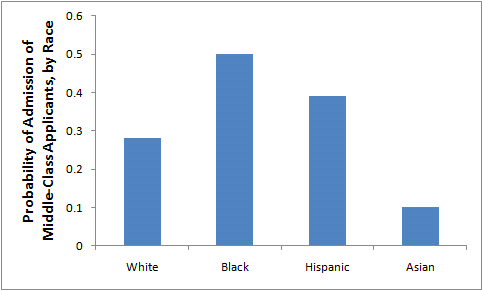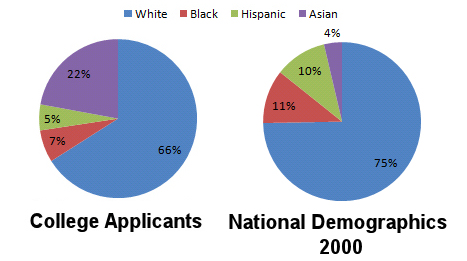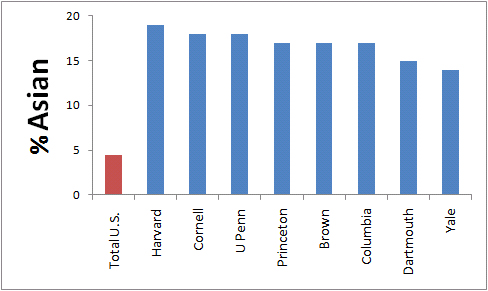This post is broken into two parts for the sake of length:
- Anti-Asian Bias in College Admissions?: Part 1 – An improper comparison
- Anti-Asian Bias in College Admissions?: Part 2 – In support of affirmative action
Since the implementation of affirmative action in the college admissions process, opponents of the policy have alleged anti-White and anti-Asian bias that reduces the chances of White and Asian high school students applying to elite colleges. Recently, a study conducted by Princeton sociologist Thomas Espenshade (published in the book No Longer Separate, Not Yet Equal: Race and Class in Elite College Admission and Campus Life) presented data that appear to support this notion.
First of all, I should point out that the primary data Espenshade analyzed were collected in 1997. But, it’s likely that the trends that Espenshade report remain in effect, since there have been no major changes to the college admissions process nationwide since then, nor have we seen significant changes in student demographics.
The “Scary Graph”: what does it mean?
Espenshade shows that middle class Asian students have a reduced probability of being accepted into private universities compared to students of other races (I re-created the graph below from page 7 of this presentation of Espenshade’s data, eliminating upper- and lower- class students, but the trends are roughly the same).
This graph looks pretty alarming until you consider the following applicant demographics, compared to national demographic information:
What this graph is showing you is that while Asian Americans are roughly 4% of the U.S. population, we represent nearly a quarter of all applicants to the institutions studied by Espenshade. For some universities, this can reach as high as 1/3 — and many of these applicants boast high SAT scores and high school GPAs. Many of these students also come from higher-income families compared to Black and Latino applicants, and therefore have access to better educational opportunities to help improve their scores. In addition, Espenshade’s data show that, compared to other races, Asian American applicants appear to preferentially apply to private institutions, which causes an even more dramatic increase in our applicant number.
Basically, the admissions percentage is low for Asians is at least in part because so many college applicants are Asian/Asian American. You can think of it this way: if 50 White students, 25 Asian students and 5 Black students are accepted to a college, but there are 100 White applicants, 75 Asian applicants and 10 Black applicants, your probability of being accepted based on race is as follows: 50% for Whites and Blacks, and only 33% for Asians — even if the absolute number of acceptances are still higher.
And certainly, we must remember that Espenshade’s study does not consider non-numerical aspects of applicant portfolios; admissions boards often favour applicants who have acceptable scores but who have also demonstrated a diversity of talents or interests, including music, athleticism, or art.
But what can’t be denied from Espenshade’s data is this: if you’re an Asian American high school student, you are competing against a lot of other, highly-talented White, Black and Asian American applicants and you have a lower probability of being accepted based on race compared to applicants of other races.
But does this mean there’s “anti-Asian bias”?
Searching for “anti-Asian bias”: an improper comparison
I caution against coming to the conclusion that Asian Americans are patently discriminated against in the college admissions process. Instead, I think what we’re seeing is the flip side of affirmative action: affirmative action argues that, all other factors being equal, an applicant who is a member of an underrepresented minority (whether race-based or class-based) will be preferred over a similar candidate who is not of an underrepresented minority.
And Asian Americans are anything but underrepresented in higher education. This columnist pulled racial demographics at Ivy League institutions from CollegeBoard.com and found that at all of these colleges, which practice affirmative action in their admissions processes, Asian/Asian Americans are over-represented compared to our national demographics:
Clearly, college admissions board aren’t outright refusing Asian American applicants based solely on race. In fact, even with affirmative action in place, Asian Americans are four times better represented at elite universities compared to our national population.
What this also means, however, is that because Asian Americans are so well represented in higher education, there is no racial “preference” for Asian/Asian American applicants based solely on race (Espenshade’s data shows high probability of acceptance for lower-class Asian Americans, which hints that less well-represented Asian ethnicities who also tend to come from lower-income families are still beneficiaries of affirmative action). Thus, we cannot compare the probability of acceptance rates for Asian Americans against those of underrepresented minorities; with affirmative action in place, those probabilities will — by definition –be higher for Black, Latino and Native American applicants. It’s not that we’re being biased against in affirmative action practices, it’s simply that we’re not benefiting from affirmative action — nor should well-represented Asian ethnicities be beneficiaries of affirmative action.
Nonetheless, this kind of comparison is tempting, because it is fueled by the entitlement complex that those who are not underrepresented minorities tend to feel. An Asian American applicant, who scores highly on his or her SAT test expects to be accepted, but, when they do not get in compared to a Black or Hispanic Non-White applicant who does, they feel as if life’s unfair. How often have applicants to college (or law school, or medical school) complained that “less qualified” minorities are skating through the admissions process on the back of affirmative action policies?
The bottom line is that underrepresented minorities are not skating through the admissions process. Universities will only accept applicants that meet a certain minimum standard for GPA and SAT — so no student, be they Black, White or Asian, accepted into college is actually unqualified. Moreover, the characterization of lower-scoring applicants who are accepted into college based, in part, on affirmative action relies on the assumption that SAT scores directly correlate with success in college life: yet, studies on the effectiveness by which SAT scores predict college success remain conflicted on whether the SATs are truly a good indicator that an applicant is “qualified” for college life. In addition, critics of the standardized tests argue that the SAT and other tests are culturally biased, and that higher-class applicants fare better in part because they can pay for test-taking prep classes that help them achieve a higher score. In other words, someone who scores a perfect score on the SATs may not actually be “better qualified” than another applicant who scores lower. Moreover, scoring highly on the SATs does not guarantee acceptance into top schools; schools nowadays emphasize breadth as well as depth, and seek out applicants who do well academically while pursuing diverse, non-academic interests.
Because of unequal opportunities that unfairly disadvantage Black and Non-White Hispanic students in college admissions, affirmative action seeks to improve representation of these minorities in each incoming student body, by preferentially choosing the underrepresented minority student when compared to a student of similar standing who is not underrepresented. As far as I can tell, this is one of the few ways affirmative action is put into practice, based on the ruling by the Supreme Court that found explicit racial quotas unconstitutional.
Thus, because neither Whites nor Asians are underrepresented on the campuses of elite universities (and thus don’t benefit from affirmative action), comparing acceptance rates for Asians against beneficiaries of affirmative action is an erroneous comparison specifically designed to whip up anti-affirmative action sentiment. It ignores the fact that Asian Americans remain, even with affirmative action, well-represented on college campuses. It uses “Scary Graphs” (like the first one in this post) to raise hysteria and resentment between Asian/Asian Americans and other racial minorities, ignoring the fact that with affirmative action in place, we know those acceptance rates will not be the same.
Instead, to determine if there is any “anti-Asian bias” in the admissions process, we should really be comparing the acceptance rates of Asian/Asian Americans against the other “non-beneficiary” group: Whites.
Continue to Part 2: In support of affirmative action




